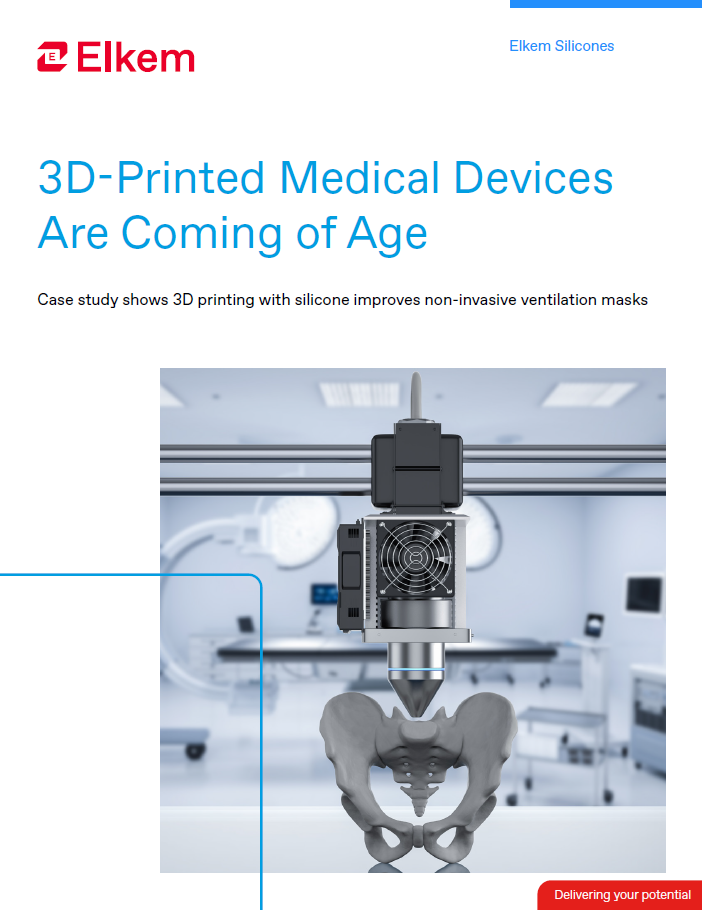
“It isn’t just the mask. It’s also the way you put the mask on the baby,” says Karsten Schlichter, global business development manager, at Elkem Silicones. “Allowing the mask to remain on the baby without the straps pushing it down and putting pressure on the skin and on the head.”
Schlichter is referring to how preterm infants are frequently given breathing support using non-invasive ventilation techniques, such as a continuous positive airway pressure (CPAP) machine. This delivers air pressure via a hose to a connected mask or nosepiece, helping the infant to breathe more easily.
However, the challenge is that the faces of premature babies are quite different to those of adults.
“They grow! They are not yet set,” points out Schlichter. “It’s a kind of iteration process where you regularly have to adapt the mask to the growth of the baby. 3D printing allows you to keep up.”
To prove this point, Elkem, the University of Barcelona and an additive manufacturing (3D printing) company have collaborated to design and produce 3D printed ventilation masks that are suitable for preterm babies. An essential element of the mask is the material – silicone.
Schlichter explains: “Silicone is an elastomeric material; it allows you to have this comfort on the face. Hard, more rigid material will put scars on the skin of the baby, [and even] on an adult it will leave stripes and marks on your face. Silicones can avoid that.”
The problem with generic medical devices
Although manufacturers make products in a variety of shapes and sizes, it is just not possible to develop a large enough selection of devices off-the-shelf to accommodate every patient and body type. Until now, medical staff have often had to make do with what is available.
However, ill-fitting, generic medical devices can lead to treatment failure. For example, studies have found that treatment with standard nasal prongs in CPAP therapy sometimes fails when the prongs do not fit correctly[i], and if a device is uncomfortable the patient may not want to wear it.
Badly fitting medical devices can also cause injury in patients, with pressure ulcers, scarring and hair loss all common occurrences. If devices are not cleaned properly, there is also a risk of ulcers becoming infected.
Customised medical devices have a better and more comfortable fit, with fewer air leaks. This is where additive manufacturing, more commonly known as 3D printing, comes in, as it allows medical staff to digitally scan the patient’s head and face using software to tailor the device to their exact specifications. A 3D printer then turns the digital file into a physical device that fits the patient perfectly.
Using silicones for 3D printing
3D printing uses three-dimensional data to ‘print’ or join materials layer by layer, to build an object. This makes it possible to construct devices with intricate structures, internal cavities and unconventional geometries that would otherwise be extremely difficult or even impossible to produce using traditional manufacturing methods, such as moulding.
Designs can be iteratively modified, reducing the number of components, weight and cost to create lightweight, compact medical devices with internal functionality.
The use of additive manufacturing or 3D printing in medical devices has grown rapidly in recent years, with diverse applications in orthopaedic, dental, interbody, surgical and customised equipment.
According to GlobalData, this ability for customisation, fast turnarounds and lower production costs is driving growth within the medical 3D printing market, rising from just over $2 billion in sales in 2022 to an estimated $4 billion in 2026[ii].
The 3D printing industry’s growing maturity and sophistication is seeing a new application-driven move towards innovation, matching relevant applications with the requisite materials. And silicone is eminently suitable for use as a 3D printing material.
Unique properties
“With silicone, you can have many formulations,” says Schlichter. “You can adjust to the final use and comfort level for the patient. The mask is on the face of the patient, but at the same time, the mask must be connected to oxygen. The mask also has to have some mechanical properties to allow the tube to go into the mask correctly with no leakage.
“Silicones are tuneable towards the patient and tuneable towards the equipment side. That is something you can do in 3D printing, because you can use multiple materials – softer, more flexible material towards the face, and harder, more rigid material where you have the connectors.
“Silicones have now become maybe the bestmaterial for elastomer parts in medical applications. That’s due to the properties of silicone, such as biocompatibility and chemical inertness.”
Silicone also offers these features: thermal stability over a wide range of temperatures; resistance to oxidation, ozone and UV exposure; and high compression and shear resistance.
To combine 3D printing and the material’s unique properties, Elkem Silicones has developed a new line of customised silicones, the AMSil™ and AMSil Silbione™ series, which are especially designed for this technology.
3D printing: a long-term vision
The proof-of-concept collaboration between Elkem and the University of Barcelona has clearly demonstrated the potential benefits of 3D-printed ventilation masks, including personalisation, effectiveness and comfort.
When the silicone device was fitted to the phantom’s face shape, leaks were reduced by 14% and, crucially, there was less pressure against the skin, potentially making it more comfortable for wearers and reducing the risk of ulcers, scarring and infection.
The study also showed that technicians can print new masks as needed, providing flexibility for the treatment teams.
Schlichter believes 3D printing is a real commitment with a long-term vision.
“Additive manufacturing will become a new, enabling technology, allowing people to produce items that you can’t produce in the same way with traditional manufacturing,” he says.
“We see silicones as a real, novel material for 3D printing, with all the applications that silicones have in their variety, from medical to industrial applications. Going forward, we are working on several technologies that will allow us to open up the space even wider for silicones in 3D printing.”
To learn more about the benefits of 3D printing in the medical device industry, and to explore the case study featured in this article in more detail, download the whitepaper below.
[i] Prongs: Risks, Injuries Incidence and Preventive Approaches Associated with their use in Newborns, Ribeiro DFC, Barros FS, Fernandes BL, Nakato AM, Nohama and P Nasal. Journal of Multidisciplinary Healthcare, Vol 3, June 2020, 13 pages: 527-537. https://doi.org/10.2147/JMDH.S252017
[ii] 3D Printing is the Future of Low-Cost Personalized Medical Devices, GlobalData, April 2023:
https://medical.globaldata.com/Analysis/TableOfContents/3D-Printing-Is-the-Future-of-Low-Cost-Personalized-Medical-Devices



